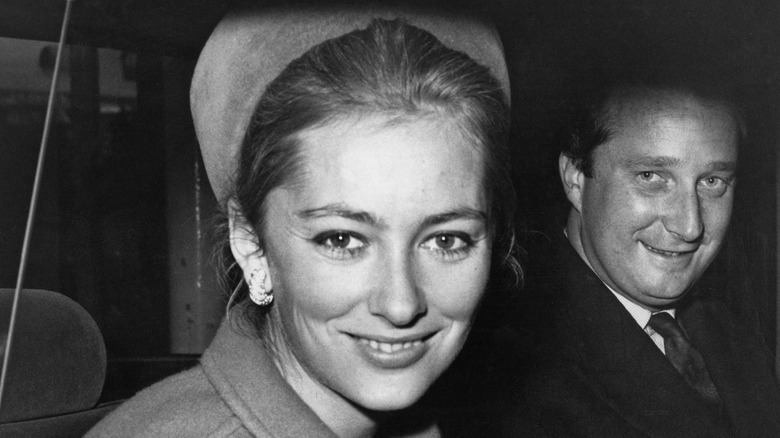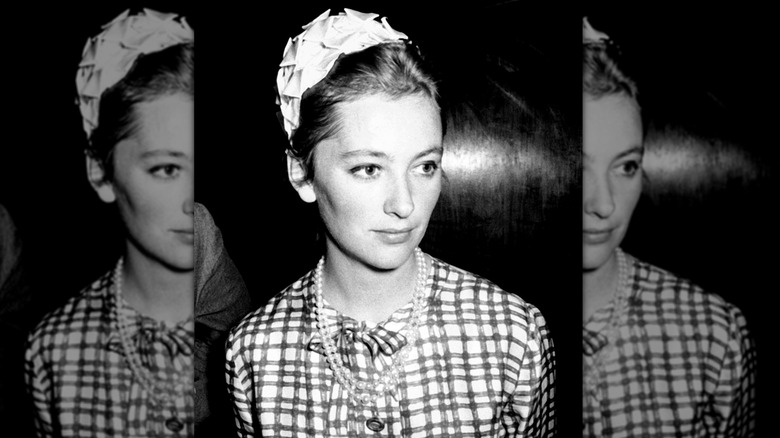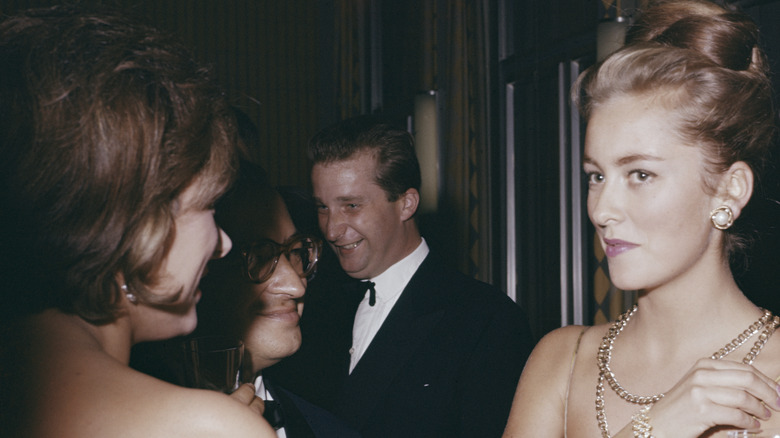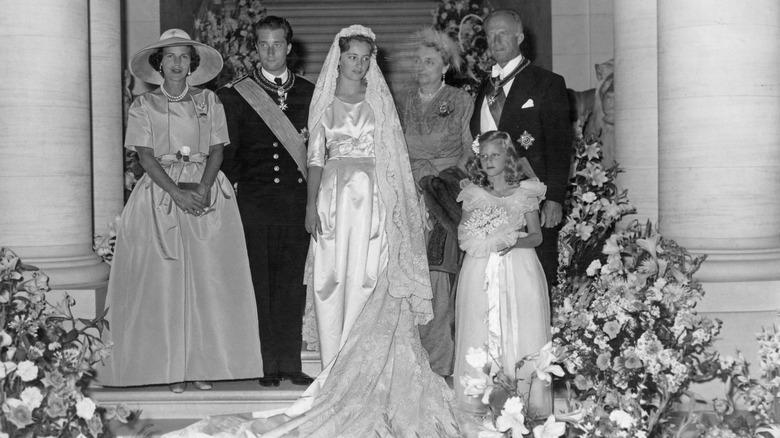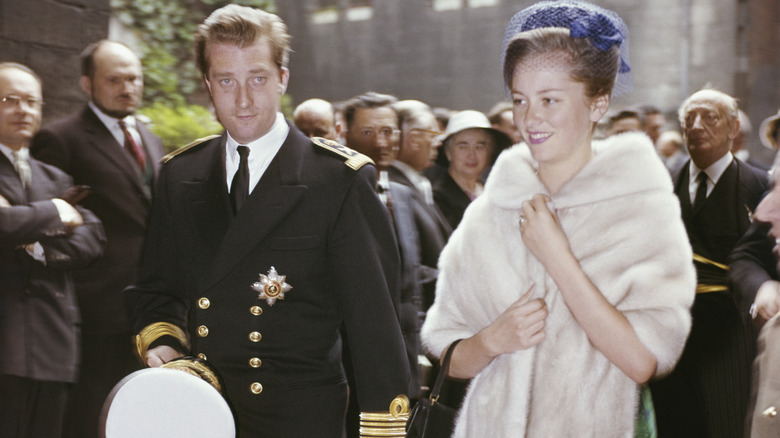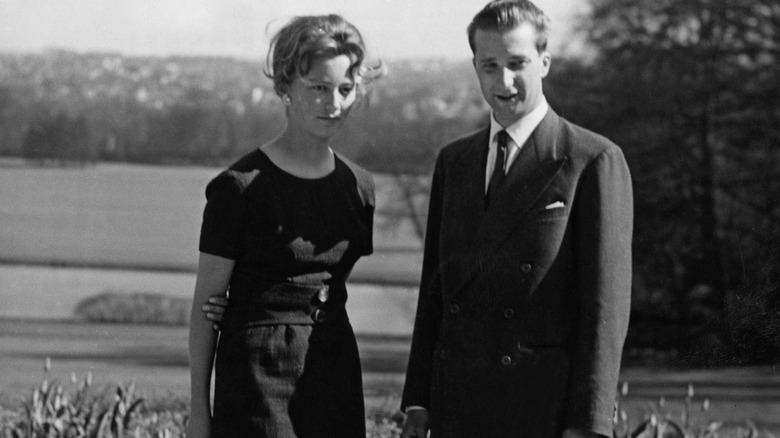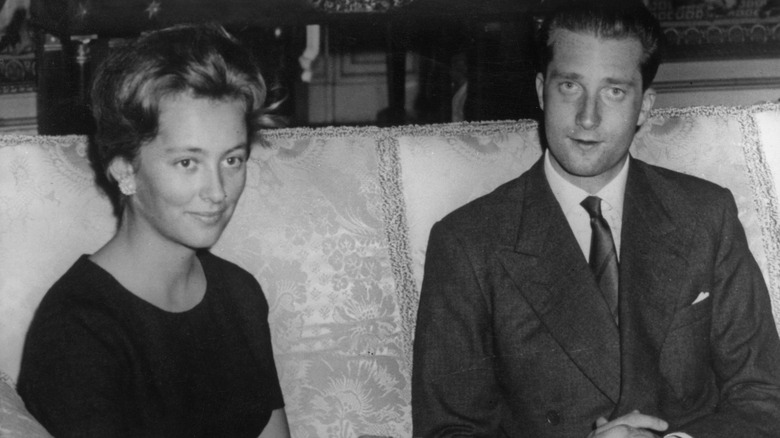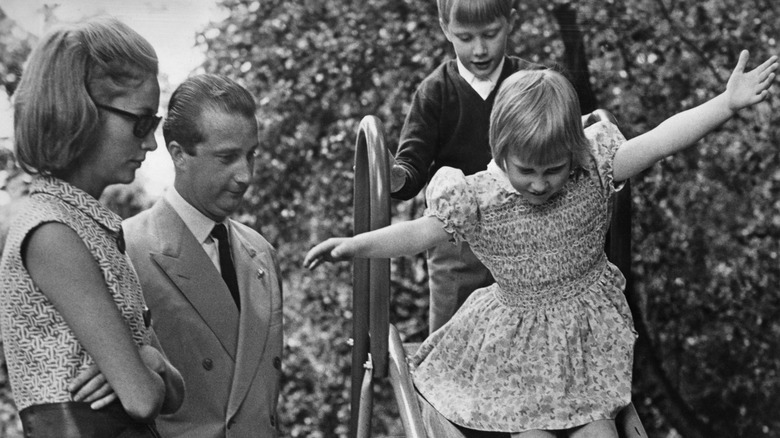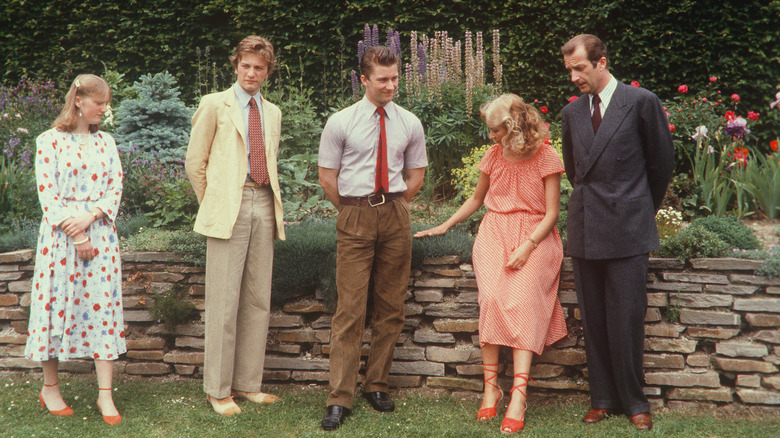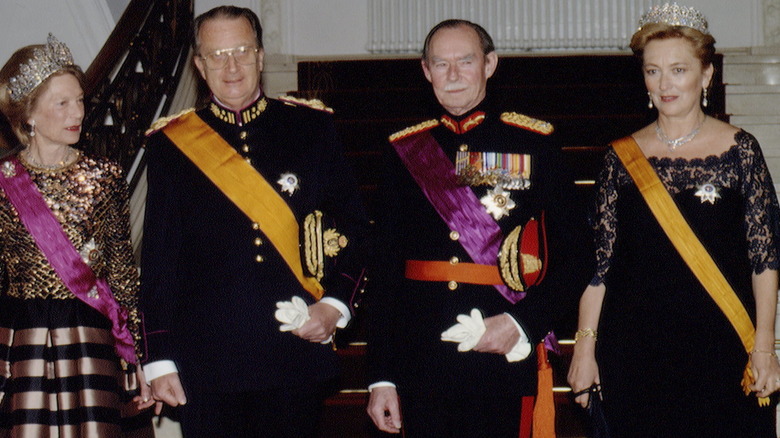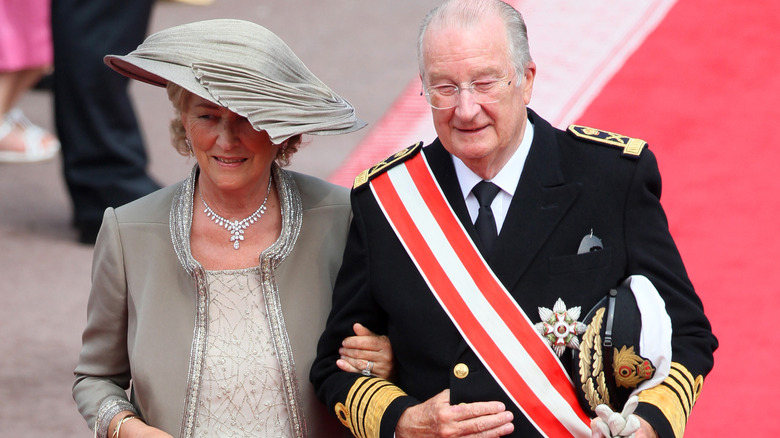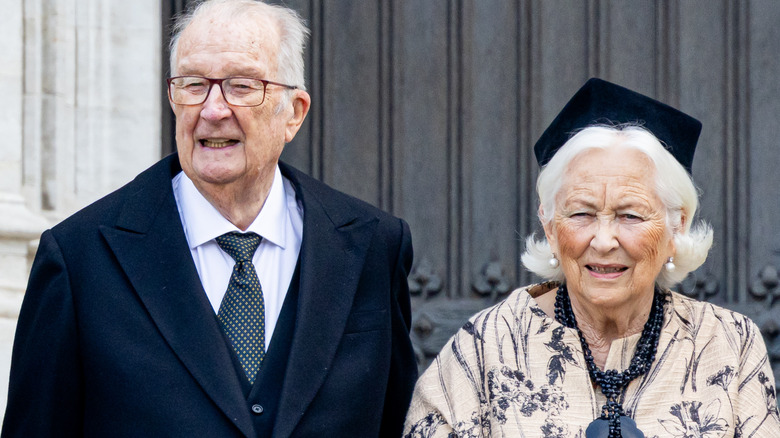The Stunning Transformation Of Queen Paola Of Belgium
When Queen Paola of Belgium came into the world on September 11, 1937, she was neither a queen nor Belgian. In fact, she was born Princess Ruffo di Calabria in Forte dei Marmi, Italy — more than 700 miles from her future home at the Royal Palace of Brussels. That being said, Paola was probably one of the most privileged babies of her day. As the daughter of Italian royalty herself, Paola was already born with some combination of wealth and fame. Her father was Prince Fulco Ruffo di Calabria, a celebrated World War I pilot who had 20 victories under his belt. Meanwhile, her mother was Countess Luisa Gazelli.
Like many other young women of means, Paola had access to a world-class education. She was sent to school in Rome, where she delved into the classics and came to master both Greek and Latin. In addition to these ancient languages, Paola learned about art history and contemporary literature.
It is possible, however, that even this fantastic education could not have prepared Paola for everything that she would face in the years to come. Unbeknownst to the princess and her loved ones at the time, Paola would go on to become the unexpected queen of Belgium. In this position, she would produce heirs, start a foundation, and endure one of the biggest, most humiliating public scandals in the history of the throne.
Paola enjoyed a delightful childhood
Before Queen Paola could even dream of becoming a royal consort, she was a young girl who lived a very idyllic life. Her hometown of Forte dei Marmi, Italy was a pleasant place to grow up, thanks to its agreeable climate and rich culinary scene. As royal expert, Mario Danneels, told Vanity Fair, "I visited the town where [Paola is] from in Italy and it's always sunny, beautiful — and the food is much better than it is in Belgium."
In this delightful environment, the young princess thrived. She fell in love with the beauty that surrounded her, dedicating herself to her love of language and literature. In a video that Paola would later film for the World Italian Language Week, she reflected on these early days, divulging that she used to enjoy reciting poetry with her late grandmother. Although Paola recorded this clip many years after she had left her native Italy, the gorgeous royal told audiences that she remembered those leisurely afternoons "as if it were yesterday." The former princess even revealed the name of one of her favorite poems from that time — Gabriele D'Annunzio's "La pioggia nel pineto."
Of course, Italian was not the only language that Paola learned to appreciate during her childhood. She was also said to have studied French, English, and even a bit of Dutch. These linguistic capabilities allowed Paola to fall in love with traveling from a young age.
She became one of Europe's most glamorous women
By the time Queen Paola was a young woman, she had all the characteristics of a successful society gal. She was wealthy, worldly, well-educated, and extremely fashionable. It certainly did not hurt that she was also considered a great beauty. Thus, it was perhaps inevitable that Paola became the talk of the town. Speaking to Vanity Fair about this dynamic, royal expert, Mario Danneels, relayed, "She was this glamorous, gorgeous princess."
Naturally, Paola's popularity with the public only increased when it became clear that she was romantically involved with another royal — then-Prince Albert of Belgium. The two began seeing each other in the late 1950s after crossing paths in Rome. Indeed, Paola and Albert both attended the coronation of Pope John XXIII at the Vatican and got along swimmingly.
Soon, all eyes were on the attractive young couple, but especially on Paola. Thanks to her remarkable beauty and iconic sense of style, the Italian princess caught the attention of the society pages time and time again. Danneels told Vanity Fair, "She was really famous in Europe in the '60s and '70s because she was drop-dead gorgeous — as beautiful as Grace Kelly— and she was followed by the paparazzi everywhere."
Paola and Albert tied the knot, in spite of governmental tensions
For a while, Queen Paola and the future King Albert II of Belgium kept their romance alive through correspondence. Their relationship, inevitably, benefited from the fact that neither of them was expected to ever become queen or king of any country. As a fourth daughter and second son, respectively, Paola and Albert were the very definition of their families' "royal spares." In other words, they were meant to wear the crown only if their older siblings were to die unexpectedly. Thus, it was not particularly difficult for Paola and Albert to convince their families to support the marriage. Both royals were blue-blooded, good-looking, and — most importantly — Catholic. A royal match was made.
While it may have been easy to get parental approval for Paola and Albert's wedding, the same could not be said about the Belgian government. Issues began to arise as soon as the couple began planning their nuptials. The Belgian royal family wanted the couple to wed in the Vatican in a ceremony officiated by none other than the pope. Unfortunately, though, the Belgian government just could not back this plan, as local politicians felt that the couple's royal wedding needed to take place in Belgium. Before a full-blown crisis developed, a deal was struck, and Paola and Albert agreed to marry twice. In July 1959, the pair wed a civil ceremony, followed by a Catholic ceremony held in Brussels.
Paola's marriage with Albert was complicated from the beginning
Queen Paola and King Albert's life as newlyweds should have been full of joy and romance. However, their relationship was overshadowed by what was then Belgium's unstable political situation. Speaking in Nicolas Delvaulx's documentary, "Paola, Garden Side," Belgian historian, Francis Balace, explained, "Paola's first year in Belgium was terrible for her ... At the time, there were tensions in the Congo, the deaths, the airlift to repatriate them. Albert has to welcome people on stretchers at Melsbroek airport. Then came the major strikes of 1960-1961" (via Paris Match).
To make matters worse, Paola struggled to get acclimated to the long Belgian winters. As Balace told Delvaulx, "Paola, 'little bird of the South,' finds herself in a country where it rains, where it is cold." For a 21-year-old who simply wanted to enjoy her life, long dreary days stuck inside a cold, northern palace were tiresome. As time went on, Paola found herself feeling deeply dissatisfied, and her unhappiness began to reflect itself in her marriage with Albert.
As Mario Danneels revealed in a conversation with Vanity Fair, "Queen Paola was very unhappy at the court ... And she was very young, 21 when she got married to Albert and moved to Brussels. The king and queen [King Baudouin and Queen Fabiola] at the time were extremely religious and court life was very somber and very solemn and it just didn't suit her. So the marriage started crumbling."
As a princess, Paola was said to be miserable
Even as Queen Paola and King Albert struggled to get along, the couple understood that they had duties to fulfill. Within just a year of tying the knot, Paola gave birth to a son — King Philippe. In 1962, the royal pair expanded their family once more with a daughter, Princess Astrid. They also welcomed a second son, Prince Laurent, in 1963.
Despite the couple's flourishing family life, Albert and Paola failed to connect on a more romantic level. As the 1960s ticked by, Albert allegedly started traveling without his wife, as he knew that Paola was unhappy in their relationship. Soon, the then-prince found himself turning more and more to a certain Baroness Sybille de Selys Longchamps, who was also said to be dissatisfied with her own marriage. According to Mario Danneels' chat with Vanity Fair, Albert and Sybille "found comfort with each other. They bonded over their failing marriages basically."
Naturally, one thing led to another, and before long, Albert and Sybille were entangled in a full-blown extra-marital affair. Their relationship is believed to have spanned for at least 15 years. However, as they reveled in each other's company, Paola suffered. In Nicolas Delvaulx's documentary, "Paola, Garden Side," Paola herself would later admit, "I was absolutely not happy at all and felt like I was a mess. I didn't know where to go" (via Paris Match).
Paola wanted to divorce Albert
As King Albert's dalliances with Baroness Sybille de Selys Longchamps raged on, things for Queen Paola went from bad to worse. This was exacerbated when Albert and Sybille welcomed a daughter, Princess Delphine, in 1968. Despite Delphine's royal titles, she was not originally recognized by her father. As a royal love child, she represented a major scandal — one that both Albert and Sybille refused to admit. Speaking on RTBF's C'est du Belge, the baroness recalled, "I was due to give birth and I lied about the date, because I did not want my husband to be present at the birth. Just before, I confided in a good friend. I asked her to call Albert directly afterwards. Normally a birth is a happy event. For me, it was a catastrophe."
Sybille was not the only person from whom Delphine's birth seemed catastrophic. Paola also grappled with the event, which left her feeling even more miserable than before. Before long, it was said that the princess wanted a royal divorce. However, apparently, she was subject to intimidation tactics before she could submit the paperwork. Albert's older brother, King Baudouin, allegedly told Paola that any formal separation would mean losing her children.
Paola agreed to remain married, but the public could sense her misery. As journalist Mario Danneels told Vanity Fair, "Everyone in Belgium knew that there had been a crisis in the marriage ... That, in the '70s, they were on the brink of divorce."
Paola withdrew into her own world
Queen Paola may not have been permitted to divorce King Albert; however, she was still able to create a good deal of distance between herself and her unfaithful husband. In the years that followed, Paola was rumored to have taken residence in a different wing of the palace — allowing her to experience something of a modern-day separation.
However, beyond the physical distances that Paola constructed between herself and her husband, the princess built emotional barriers, as well. Touching on this issue in her interview with Nicolas Delvaulx, Paola recalled, "I [hadn't] been happy for ten years ... I distanced myself from everything for ten years, from 1970 to more or less 1980. I was often alone during these ten years. I was very unhappy and very sad" (via Paris Match).
Unfortunately, though, as Paola grappled with her negative emotions, her public image took a hit. While most Belgians knew that Paola and Albert were having marital issues, they did not know about the prince's secret daughter. Thus, from an outsider's perspective, it looked like the dour princess was casting a somber shadow over her own marriage. "She was very shy and was not very outgoing and not very popular as a result," Mario Daneels told Vanity Fair.
The royal matriarch learned to cope with these challenges
Eventually, Queen Paola came to understand that the only person she was making miserable was herself. Rather than simply withdrawing into her own sadness, Paola found other activities to absorb her time. Perhaps out of a desire to recreate the happier days of her childhood in Italy, the stunning royal began putting her efforts into beautifying the world around her. As she would later explain in the documentary, "Paola, Garden Side," "I developed a passion for gardening and nature. A passion for home, which I wanted to be attractive. Among other things, very good cuisine" (via Paris Match).
That being said, as Paola grew more invested in the world around her, she began to understand all the damage that she had done during the decade of her misery. As she spent years suffering behind cold palace walls, Paola's children were left without the full brunt of their mother's love. In retrospect, Paola says that this is one of her biggest regrets. She told documentarymakers, "It's a shame that we can't repeat things, repeat the years, because now, I understand how important it is to give affection."
Despite being unable to change the past, though, Paola has tried to compensate for her past failures by doting on her grandchildren — some of whom were born in the 1980s. As she revealed in the same documentary, "The children say: "At Nonni's, we eat well!"
She officially became queen in 1993
In 1993 tragedy struck, and King Albert's older brother, King Baudouin, died. With no heir to speak of, Baudouin was succeeded by Albert, making Paola queen. For the Italian-born royal, her ascension to the throne represented a major shift in responsibilities. No longer could she remain locked in a back room, ruminating over all that had gone poorly. Now, she would need to invest time into larger projects of her own. As royal expert, Jeffrey Lee, put it in his book, "Crown of Venus," "The Belgian monarchy is naturally loathe to describe the queen as simply being a biological vessel for continuation of the royal succession, so it simply declares that she 'assists the king in the exercise of his duties as a Head of State.'"
In Paola's case, this meant doing her part to protect the cultural value of the palace. According to Lee's reporting, the official palace website previously explained that Paola "often visits craftsmen and encourages the exercise and training of traditional professions. In the same area, she has a strong interest in art history and more specifically in the preservation and restoration of our cultural heritage and of the royal palace in particular." She also doubled down on her project in the gardens, extending it to several different green spaces. The palace website also relayed that the queen had "personally designed her own garden, and she closely supervises the maintenance of the various royal parks and gardens."
As they got older, Paola and Albert reconciled
As Queen Paola grew into this new phase of her life, she found herself making amends with her husband. Indeed, as the two began working together more and more, the royal couple felt their previous spark reignite. On one occasion, King Albert approached Paola with a declaration of love. As the queen shared in "Paola, Garden Side," "And then he said to me, 'I've always loved you.'" And while she could have brushed this sentiment aside, Paola found herself embracing it. Recalling that moment years later, the queen divulged, "It was a pleasure" (via Paris Match).
Following that interaction, Paola and Albert began to rebuild their marriage. And, from what we can tell, their efforts were largely successful. As one unnamed source told documentary makers, "From 1993 to 2013, she accompanied her husband magnificently ... And on a personal level, she succeeded in this second life thanks to acceptance of the past, understanding and mutual love." All in all, this led to a new phase not just for Belgium but also for Paola. "She is proud to have been able to take this path of reign as a couple, but also to have found new marital fulfillment. She found harmony at the end of a real life journey. This speaks to everyone: we can experience difficulties and find happiness again. As such, its story is exemplary," the insider added.
In her old age, Paola says that she is happy
After many years of emotional hardship, Queen Paola is finally happy. She has re-evaluated her priorities, choosing to value the people that she cares about the most. A far cry from the woman who once withdrew from all the people she loved, the modern Paola dedicates her time to her children and grandchildren. As stated by the Belgian Monarchy, "Family plays a key role in Queen Paola's life. Like any grandmother, Queen Paola enjoys spending time in the company of her grandchildren."
Paola has also put more of herself into her relationship with Albert. Following their abdication from the throne in 2013, the couple has continued to build their romantic connection. And, despite all that they went through during their early years, Paola and Albert seem to get along quite well. At a celebration for the queen's 70th birthday in 2007, she told reporters, "We've had our problems ... but now we both say that we were meant for each other. We are very happy now" (via Vanity Fair).
For Paola, the biggest challenge was learning how to deal with love — how to open herself to it, feel it, and give it. However, as an older woman, she feels more confident. As Paola revealed in the documentary, "Paola, Garden Side," "I am more and more fascinated by the love that inhabits me now and the love that I aspired to at 20" (via Paris Match).
